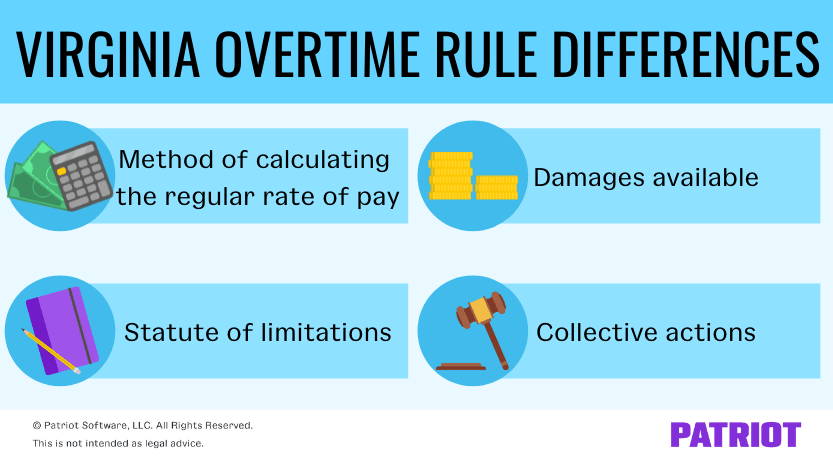Part of your role as an employer is following payroll laws and ensuring your employees are accurately paid for their wages and other rates, like overtime. If you’re a Virginia employer, buckle up, because there’s a new overtime law in town: The Virginia Overtime Wage Act. Get to know all the facts about the Virginia overtime law before it goes into effect this summer.
Virginia overtime law: Your top questions, answered
The Virginia Overtime Wage Act (VOWA) was signed into law on March 31, 2021 and is set to go into effect on July 1, 2021. The Virginia overtime law creates new hours and wage requirements for employers in Virginia. VOWA also includes a number of protective measures for employees.
Before the law was passed, Virginia did not have its own overtime pay statute. Instead, employers in Virginia had to follow the federal Fair Labor Standards Act (FLSA) regarding wage and hour requirements for employees.
As a brief recap, the FLSA protects employees by establishing:
- Minimum wage requirements
- Overtime rules
- Child labor laws
- Hours worked rules (e.g., paying for breaks)
In addition to enforcing overtime laws, the FLSA also sets guidelines for exempt vs. nonexempt employees and protects nonexempt employees. Nonexempt employees are eligible for overtime pay (aka time and a half). To be nonexempt, an employee must meet at least one of the following:
- Receives hourly wages
- Earns below the exempt threshold of $35,568 annually (or $684 per week)
- Does not have executive, administrative, or professional job duties
For a long time, Virginia employers had to use FLSA guidelines when calculating and paying overtime wages. But now, the Virginia Overtime Wage Act is taking over that role.
How does the new Virginia overtime law work?
Although the VOWA has some similarities to federal FLSA requirements, it deviates from the Fair Labor Standards Act in certain aspects.
Like with the FLSA, the new law for overtime pay in Virginia still requires employers to pay eligible workers an overtime rate of at least 1.5 for hours worked over 40 in a workweek.
The VOWA also incorporates most FLSA exemptions by excluding certain workers from overtime. However, the VOWA expands the definition of a covered employee, allowing some workers typically exempt from overtime under the FLSA to be eligible. To ensure you do not misclassify an employee under the new law, double-check that employees not currently receiving overtime are still excluded under the VOWA.
Under the new Virginia wage and hour law, there are a few changes employers need to know. Here’s how the Virginia overtime rule differs from the federal regulations:
- Method of calculating the regular rate of pay
- Statute of limitations
- Damages available
- Collective actions
Method of calculating the regular rate of pay
Like the FLSA, the VOWA generally requires employers to pay nonexempt employees an overtime rate of 1.5 for hours worked over 40 in a workweek. However, how you calculate the employee’s regular rate of pay can vary under the new law.
For nonexempt hourly workers, the method for calculating the regular rate of pay under the VOWA is the same as the FLSA. To calculate a nonexempt hourly worker’s regular rate of pay, take the sum of the worker’s hourly wages and other non-overtime wages for the workweek and divide it by the total number of hours worked for the workweek.
The legislation states, “[F]or employees paid on an hourly basis, the regular rate is the hourly rate of pay plus any other non-overtime wages paid or allocated for that workweek, excluding any amounts that are excluded from the regular rate by the federal Fair Labor Standards Act, 29 U.S.C. § 201 et seq., and its implementing regulations, divided by the total number of hours worked in that workweek.”
When it comes to nonexempt salaried employees, the regular rate of pay for the VOWA differs from the FLSA. Under the Virginia law, a salaried employee’s regular rate of pay is one-fortieth of all wages paid for a particular workweek, regardless of how many hours they worked. Under the FLSA, you calculate a salaried employee’s regular rate of pay by dividing the salary by all hours worked.
Until the state issues further guidance on overtime calculations, employers may want to do the following for nonexempt salaried workers:
- Temporarily reduce overtime work
- Transition nonexempt salaried workers to an hourly rate for the time being
For remaining nonexempt salaried employees, employers must update the method for how they calculate regular and overtime rates to comply with VOWA rules by July 1.
Statute of limitations
Under the VOWA, the statute of limitations for unpaid overtime claims and violations is three years. The three-year statute of limitations applies to all violations, regardless of whether a violation was intentional.
The FLSA’s statute of limitations is two years if unintentional and three years if the employee can prove the violation was willful.
Damages available
The FLSA provides for liquidated damages (e.g., payments to an employee for overtime wage violations) equal to the amount of unpaid overtime wages. Under FLSA rules, an employer can defend against liquidated damages by proving they were acting in good faith and complying with the FLSA’s requirements.
Under the new law, this defense is not available for employers, and liquidated damages are automatic. All overtime wage violations are subject to double damages. Employers may face greater liability for misclassifying employees as exempt. And under the VOWA, “knowingly” failing to comply with the law can result in treble damages.
Employees suing under the Virginia Overtime Wage Act may also recover an 8% prejudgment interest penalty and reasonable attorneys’ fees and costs.
Collective actions
Virginia law typically does not allow class or collective actions (e.g., a group of employees sue their employer for overtime wage violations). However, the VOWA makes an exception to this rule.
The new VA overtime law allows collective actions “consistent with the collective action procedures of the Fair Labor Standards Act.” Basically, the VOWA authorizes employees to bring a private action to court individually or collectively.
With this change, Virginia employers could potentially have to defend overtime violation claims of multiple employees in a collective lawsuit.
When does it go into effect?
Again, the new Virginia overtime wage law goes into effect on July 1, 2021. Starting July 1, Virginia employers will be subject to the new state overtime pay requirements.
What else do I need to know about the new overtime law?
Again, the new Virginia overtime law requires time-and-a-half pay for overtime hours. Because of this, any half-time pay rates to compensate workers for overtime may potentially be illegal under the VOWA. This might include:
Although courts still need to interpret the law to determine what’s legal and what’s not, Virginia employers may want to consider eliminating the above types of rates in the meantime to be on the safe side.
Stay tuned to find out how the courts interpret the law and what you cannot do under Virginia’s new overtime law.

How to calculate Virginia overtime rates under the new law
Again, how to calculate an employee’s regular rate of pay has slightly changed based on if the nonexempt employee is hourly or salaried. For hourly nonexempt employees, use the FLSA’s calculation. But for nonexempt salaried employees, use the new method of calculating regular rate of pay and overtime. Check out examples of each below.
Salaried nonexempt employee
Say you have a nonexempt salaried employee with a weekly salary of $1,000. To calculate the salaried employee’s regular rate of pay under the Virginia Overtime Wage Act, use the following formula:
Regular Rate of Pay = Weekly Salary / 40
$25 = $1,000 / 40
The salaried employee’s regular rate of pay is $25 per hour.
Say the same employee worked 45 hours during the workweek. To calculate the salaried worker’s overtime rate, multiply their regular rate of pay by 1.5.
Overtime Rate = Regular Rate of Pay X 1.5
$37.50 = $25 X 1.5
The employee’s overtime rate is $37.50 per overtime hour.
Calculate the employee’s overtime pay by multiplying their overtime rate by the number of overtime hours for the workweek.
Overtime Pay = Overtime Rate X Overtime Hours
$187.50 = $37.50 X 5 hours
The employee’s overtime pay for the week is $187.50. Add the employee’s overtime pay to their regular wages to get their total weekly pay of $1,187.50 ($1,000 + $187.50).
Hourly nonexempt employee
To calculate a nonexempt hourly employee’s regular rate of pay, use the same method as the FLSA.
Say your nonexempt hourly employee makes $20 per hour and worked 50 hours during the workweek. They also received a $100 bonus during the period. Here’s what the employee’s regular and overtime rates would be:
Regular Wages = (Hourly Rate X Total Number of Hours) + Other Nonovertime Wages
$1,100 = ($20 X 50 hours) + $100
Regular Rate = Total Regular Wages / Total Number of Hours
$22 per hour = $1,100 / 50 hours
Overtime Rate = Regular Rate X 1.5
$33 per hour = $22 X 1.5
The hourly employee’s regular rate is $22 per hour, and their overtime rate is $33 per hour.
Virginia Overtime Wage Act: Fast facts to keep in mind
Wowza, that’s a lot of information to digest. Luckily, we summed it up for you all right here. Check out some fast facts about the new Virginia Overtime Wage Act:
- Goes into effect on July 1, 2021
- Requires Virginia employers to pay eligible workers an overtime rate of at least 1.5 for hours worked over 40 in a workweek
- Expands the definition of a covered employee
- Incorporates most, but not all, FLSA exemptions by excluding certain workers
- Potentially changes who is eligible for overtime pay
- Differs when it comes to the regular rate of pay calculation, statute of limitations, damages available, and collective actions
- Uses a different regular rate of pay calculation for nonexempt salaried employees than the FLSA (calculation for nonexempt hourly employees is the same as the FLSA’s)
For more information about Virginia’s new overtime requirements, consult the state and review the legislation.
Calculating overtime doesn’t have to be a hassle. To simplify the process and easily record, calculate, and pay your employees, use Patriot’s online payroll. What are you waiting for? Start your free trial today!
This is not intended as legal advice; for more information, please click here.



